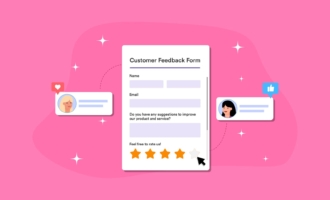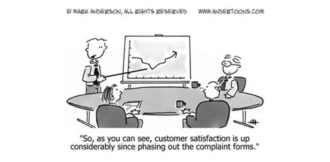If you’ve ever sold anything on eBay, you know the importance of customer feedback. A color-coded star rating and positive reviews can boost your reputation and drive new business.
On average, eBay customers leave feedback for an estimated 20 to 30 percent of successful purchase experiences. But when a transaction goes bad, an estimated 90 percent of customers leave feedback about their poor experience.
This phenomenon isn’t limited to eBay. Businesses more often hear from customers when they’re unhappy. When things go well, customers may think feedback isn’t necessary.
Collecting a steady stream of customer feedback is crucial for your business. When you’re in touch with customer sentiment — good, bad, and neutral — on an ongoing basis, you’re better positioned to fix problems quickly and effectively, which can help your company grow.
But customer feedback doesn’t just happen. Sure, you might be lucky enough to have a conversation with a customer in passing or read customer reviews about your product or service online. But this won’t be enough to provide a comprehensive picture of customer sentiment, and it won’t create an organized pool of feedback data that can support smart decision-making.
You need well-defined systems and processes for soliciting, collecting, and categorizing feedback, so you can act upon it in the most appropriate and effective way. You can also develop processes to follow up on customer feedback, helping build trust and reciprocity with customers to drive real change for the better.
This guide will cover the principles of customer feedback, how it works, and tips to integrate customer feedback into your business. Topics include
- What is customer feedback and why does it matter?
- Types of customer feedback
- The customer feedback loop
- Feedback questions to ask your customers
- Companies that have effectively collected and used feedback
- The basics of a customer feedback strategy
- How to request customer feedback
- How to collect customer feedback
- What to avoid when collecting feedback
- Software options to help collect customer feedback
- Customer feedback management best practices
- How to categorize, analyze, and act on customer feedback
- Why following up on customer feedback can make a big difference in your business
- Tools and tips to support your customer feedback strategy
Customer feedback is about much more than a business’s image. It helps you know what’s working and what’s not, and where your business needs to improve — from the perspective of your most important asset: your customers.
Let’s get started.
What is customer feedback and why does it matter?
Customer feedback is information provided to a business that describes customers’ thoughts, experiences, and reactions about that business’s products and services. Customer feedback can be casual, like when a business owner chats with a customer in the store about whether they enjoyed their last purchase, or it can also be highly structured and formalized — such as feedback gathered from a survey, focus group, or customer review website.
5 reasons why customer feedback is essential
When managed properly, customer feedback is a powerful tool with several functions. Here are five ways customer feedback can help a business.
1. It gives customers a voice
Customers are your business partners — perhaps the most important ones. Especially today, when social media offers opportunities for direct communication, customers expect to be listened to, cared for, and appreciated.
How your company responds to feedback can make or break your customer relationships. In fact, 42 percent of customers would stop buying from a brand altogether after just two bad service experiences, according to the 2022 Gladly Customer Expectations Report. Alternatively, 59 percent of customers would recommend a brand to a friend based on service alone. Customer feedback facilitates and enhances the connection between your business and customers.
2. It builds loyalty and trust
Customer feedback can create a loop of positive reinforcement. Companies request feedback from customers, making them feel empowered and appreciated. As long as the feedback is received in good faith and acted upon appropriately, customer trust and loyalty increases. This loyalty leads to positive reviews, which enhance your business’s reputation and attract new customers.
3. It helps improve products and services
No one is better positioned to critique your product or service than your customers. They have already bought it and used it, and they can help you pinpoint how to make it better.
Surveying your customers and finding out what they like and don’t like about your offerings gives you information you can use to upgrade product design, alter pricing, implement new features or package options, and make other adjustments to improve customer experiences.
4. It measures customer sentiment
Running a business involves managing lots of moving parts, which makes it challenging to stop and consider what each customer is thinking. However, customer sentiment is a key benchmark of business success.
For example, let’s say a company launches a new product, and sales are good. But what do customers really think about the product? How are they using it? Would they recommend it to friends or buy it again? All these questions can be addressed with customer feedback. With an effective customer feedback system in place, measuring customer sentiment becomes a built-in component of a business’s decision-making process.
5. It drives innovation
One of the best attributes of customer feedback is how it can lead a business to its target audience. For example, the gender-neutral underwear brand TomboyX launched its unisex boxer briefs as a direct response to a customer request. The product has since become a bestseller. By remaining receptive to customer feedback, you can drive innovation and open up new avenues of profitability.
Gathering customer feedback isn’t hard to do
You don’t need an MBA or the services of a strategist to begin gathering, analyzing, and reaping the benefits of customer feedback. And not every business needs an expensive software system to properly collect and use customer feedback.
There are lots of ways to gather customer feedback for your business. But first, you need to understand the basics of customer feedback, including what types of customer feedback exist and how to best use them.
Let’s explore the different types of customer feedback and why they matter.
Types of customer feedback
Not all feedback is the same, and businesses need to collect different types of feedback to form a complete picture of customer sentiment.
The type of customer feedback that’s most appropriate and useful depends on the business and its offerings. Businesses that sell products need to know what customers think of the product’s features, functionality, and quality. They can get this kind of feedback via customer reviews or product ratings.
If a company offers a service, it needs feedback on different aspects of the business, like customer support, service quality, the ability to meet deadlines, and communication. These can be assessed with surveys or email campaigns.
Common types of feedback
The three main types of customer feedback are given feedback, requested feedback, and observation feedback. Let’s take a closer look at each one.
Given feedback: Build it, and they will come
Given feedback is something the customer provides with no prompting from the business. Basically, the feedback isn’t requested — rather, the customer initiates the feedback on their own.
Unfortunately, this type of feedback is usually given in response to a problem. Many customers will reach out to complain or notify management about an issue. Satisfied customers typically don’t take the time to reach out and say how happy they are with a transaction.
Most often, given feedback comes in the form of calls to customer hotlines or support requests to the customer service department. In other cases, given feedback occurs within a framework already set up to receive it.
For example, sites like eBay and Amazon have built-in feedback systems that customers can use. Sellers don’t request feedback per se, but the channel is already in place. You can increase your given feedback by creating your own feedback channels and providing customers with ample opportunities to provide feedback.
Requested feedback: If you don’t ask for it, you don’t get it
While customers sometimes initiate the feedback process, it’s not enough to rely on given feedback. Businesses can increase the flow and quality of customer feedback by asking for it. This is known as requested feedback.
You can collect requested feedback via surveys and questionnaires sent by email, or even something as simple as a feedback button on your site. To incentivize customers to fill out a survey, offer a small participation gift, whether it be a discount, promotional item, or other perk.
Focus groups and customer interviews are great ways to get more in-depth and detailed feedback. Flash polls, like those that randomly appear on a web page, can be effective for getting quick feedback on a specific issue.
The secret to getting great requested feedback is asking for it at the right time and place. For example, it makes sense to request feedback about a product only after you have given the customer enough time to form an opinion of it.
Observation feedback: Actions speak louder than words
You can gain a lot of insight by watching what customers do. This is known as observation feedback.
For example, by monitoring support tickets or tech support requests, businesses can get a good idea of the issues customers are having with their products. Another way to gather observation feedback is by tracking customer activity online, such as the most popular articles or highly searched topics and products on a business’s website.
Email campaigns can also provide observational feedback. For instance, email open rates or churn rates (how many customers unsubscribe from email lists) provide a clear picture of customer engagement and interest levels.
Observation feedback is a gold mine because there’s no limit to the ways a business can collect and use it. Almost every interaction with customers is an opportunity for observation feedback.
A circle of growth
Whichever types of customer feedback you use, it’s important to remember that customer feedback isn’t a one-way street. It functions as a loop, driving insights that lead to follow-ups that ultimately drive even deeper insights. There’s no end — only an efficient feedback process that helps a business improve and grow.
The customer feedback loop
Getting feedback from customers is never just about letting them talk. It’s an ongoing, two-way interaction. That’s why it’s often described as a loop. In business strategy, it’s also known as the ACAF Customer Feedback Loop.
ACAF — which stands for ask, categorize, act, and follow up — provides a framework for an ongoing, self-driving flow of customer feedback. Gathering customer feedback is just the first step in the process. What businesses do with the feedback data determines its value.
To get the most out of customer feedback, you have to organize and process it, create actionable insights, and examine the impact after you’ve implemented it. This is why the ACAF Customer Feedback Loop is so helpful; it creates a structure to follow.
To open this loop, you must first request feedback from customers. Let’s take a look at what questions you can ask to request feedback and some examples of companies that have done so effectively.
6 feedback questions to ask your customers
We’ve established how crucial it is to request customer feedback rather than simply wait for it to be given. But what sort of feedback questions should you ask to get the information you need? Here are some helpful examples.
Learn about the purchase experience
Customer feedback surveys are a core business competency for Matt Seltzer, market research and strategy consultant at S2 Research. He advises his clients to ask these three questions:
- Why did you choose to purchase from us?
- What was the most memorable part of your purchasing experience?
- What could we do to make your experience even better?
“Customer feedback is a great way to gain marketing intelligence, and these questions work to address the marketing life cycle of your customers,” says Seltzer.
He explains that the first question addresses the customer’s need state, which you can use to inform future marketing efforts. The second question addresses the experience itself, which is often the most critical factor in whether a customer will purchase from you again. As for the third question, Seltzer says, “It effectively brings the customer into the marketing brainstorming process with you, so you can develop even more interesting and innovative marketing campaigns in the future.”
Seltzer notes that if you’re only asking for feedback from a small number of customers, you should keep questions open-ended and be sure to review every response. If you expect a high volume of responses, use multiple-choice answers instead. This option will help you compile the answers more quickly. You can then build key performance indicators (KPIs) from your aggregated results.
Gain insights about your business
Dylan Max, head of growth marketing at Netomi, has performed extensive research on user and customer feedback questions. He recommends asking customers these questions:
- On a scale from 1–10, how would you rate your experience today?
- What was your favorite (or least favorite) part about our service?
- How did you hear about us?
Max says the first question helps you evaluate how your business is performing overall. The easier the questions are to answer, the greater the number of responses you’ll get. The more responses you get, the more confidence you’ll have in what the answers tell you about how your business is doing.
For more clarity on what you can improve, you can focus the second question on discrete service areas such as product quality, customer service, price, facility cleanliness, etc. Max suggests including space beneath these options for customers to write comments.
Even if there are complaints you can’t address, such as a product price, customer feedback helps you determine if your product is properly positioned in the market. For example, you may change your messaging to emphasize that your product is responsibly sourced, organic, or specially formulated.
“The last question is great for understanding how and where to spend your marketing dollars to reach customers,” notes Max. Customer response will help you figure out where to make changes. Should you spend more on online advertising and less on billboards? Is it worth the effort to pitch local press to write about you? Would advanced customer service training for your employees pay off with glowing word-of-mouth marketing?
Listening to your customers can give you the answers you need.
Now that we’ve looked at the types of customer feedback and some sample questions, let’s explore companies that have effectively used these techniques to collect, analyze, and incorporate customer feedback into their business models.
See “9 feedback questions to ask your customers” for more examples.
3 inspiring customer feedback examples
As competition for consumer attention gets tougher, good customer feedback means being responsive 24-7, and — more importantly — making customers feel that their feedback was heard and acted upon.
Below are three great customer feedback examples and takeaways every business can use to make improvements.
1. Uber
Uber, the popular ride-sharing service, enables customers to rate their drivers in real time with a simple tap in the Uber mobile app. The process of giving feedback is embedded in the customer journey (both the actual ride and the marketing journey) and feels seamless and natural for the customer.

Since the app prompts users to provide feedback immediately, customers are more likely to remember their experience, good or bad, and record it correctly. Moreover, Uber uses feedback as currency — drivers know their passenger feedback will impact their future income, which motivates them to make the extra effort to get a good review.
2. JetBlue
JetBlue aimed to differentiate itself from the competition by being great at customer service. “We call ourselves a customer service company that happens to fly planes,” says Laurie Meacham, manager of customer commitment.

Unlike other airlines that balk at negative feedback, JetBlue maintains an active and responsive conversation with its customers. Customers who engage with them get a clear message that they are heard, their opinions are valued, and the time they invested in giving feedback won’t go to waste.
3. Best Buy
A decade ago, Best Buy was floundering. After steady growth in the ’90s and early 2000s, shares plunged in 2012 as online shopping became more popular. Best Buy was seen as out of touch with customer demand.

Three years later, the company was back on track, largely due to an increased focus on customer feedback. Best Buy initiated an innovative strategy that awarded customers points for giving feedback on its products and services.
Customer feedback: It’s worth it
As these customer feedback examples demonstrate, when brands invest in smart, innovative practices, customer feedback can become a powerful tool for business growth.
Next, let’s talk about strategy. It’s important to have a strategy in place to set you up for success. Let’s learn a little bit more about the basics of customer feedback strategy before we dive into the deeper methodology.
To learn more about how Uber, JetBlue, and Best Buy are using customer feedback, check out “3 inspiring customer feedback examples.”
The basics of a customer feedback strategy
When you begin planning your customer feedback strategy, think back to the customer feedback loop we discussed earlier. The ACAF customer feedback loop provides an easy-to-understand framework for your business to follow while you’re building your own strategy. Let’s break down the steps to getting the most from your feedback strategy.
Phase 1: Ask
To use customer feedback, you first need to ask for or collect this information from your customers. The methods you use will depend on your customer base, software of choice, and business needs. However, this step is essential to setting up the rest of your strategy for success. Ineffective feedback collection can lead to inaccurate results.
Phase 2: Categorize
Once you have the data you need, it’s time to filter and sort it into actionable categories. When your feedback first comes in, it will likely be disorganized. Start by organizing responses into three main categories: product feedback, customer service feedback, and marketing and sales feedback. After you’ve organized it, you can start analyzing and understanding the true value of this information.
Phase 3: Analyze
Although this may not be a step in the ACAF framework, analysis is essential for getting clear, actionable takeaways from your customer feedback data. Whether you choose to perform this step manually or through automated tools like AI, taking the extra time to understand your data at a granular level can optimize your final results.
Phase 4: Act
After you’ve organized and analyzed your data, it’s time to share your findings with the people who can enact change. Logging your data effectively and sharing it with the right stakeholders is key to implementing feedback effectively. Be sure to track the progress to ensure feedback is not left on the backburner once it leaves your hands.
Phase 5: Follow-up
Many companies make the mistake of ending their strategy after the “act” phase. However, to maintain the loop of your feedback strategy, it’s important to follow up with your customers. Whether directly or indirectly, following up on feedback helps you identify whether the changes you made provided a solution to the original feedback. It also allows you to show your company’s dedication to transparency and maintains your relationship with customers.
Now that you have a better idea of what it takes to build a successful customer feedback strategy, let’s learn more about how to perform each step.
Methods of collecting customer feedback
Feedback that’s offered by customers without prompting is great — but it’s not nearly enough.
Businesses that constantly solicit customer feedback have a much larger pool of data to support informed decision-making. Also, a rich and active customer feedback loop facilitates dialogue to help improve products and services and increase customer satisfaction — which are key to building a strong business.
But customer feedback doesn’t appear out of nowhere. To keep up the feedback flow, businesses must be proactive. And that means asking customers for feedback directly.
Ask what, exactly?
First, let’s take a look at some common customer feedback methods. Here are three of the most popular and effective ways to assign scores to customer feedback.
Net Promoter Score (NPS)
Your Net Promoter Score (NPS) is determined by the answer to one question: Would customers recommend your product or service to their family and friends?
To get your score, ask customers to simply rate how likely they are to recommend your business on a scale of 1 to 10, with 10 being most likely. Those who respond 9 or 10 are considered “promoters,” 7 to 8 are “passives,” and those scoring under 6 are “detractors.”
The total NPS score is determined using the following calculation: percent of promoters – percent of detractors. The higher the NPS score, the more likely customers are happy to recommend the business.
NPS helps businesses understand whether customers are currently satisfied, while also providing a reliable indicator of potential growth. After all, customers who are happy with a business will be more inclined to recommend it and bring in new customers, while those who are dissatisfied won’t.
Customer satisfaction score (CSAT)
The customer satisfaction score (CSAT) is one of the simplest customer feedback scoring methods. It’s based on the question “How satisfied were you with your purchase/experience?” Answers are given on a scale, such as 1 to 10, with 10 being “highly satisfied.”
CSAT is useful for measuring customer satisfaction with products and services over time. The same question asked on the day of purchase compared to one month or two months later can provide an overview of how the customer’s experience with a product changes.
Because the CSAT is such a straightforward feedback technique, businesses can use it several times with the same customers without being a nuisance.
Customer effort score (CES)
This metric can help determine how easy it is for customers to interact with a business. The customer effort score (CES) isn’t a numerical measurement. Rather, it’s based on a scale of “positive” to “neutral” to “negative.”
Here’s an example of a typical CES question: “How helpful was your customer service experience today?” The answer scale includes the following answers, from best to worst:
- Very helpful
- Helpful
- Neutral
- Unhelpful
- Very unhelpful
The total CES score is calculated by subtracting the percentage of positive responses from the percentage of negative ones. A low average customer effort score means customers have to work hard to get what they want from the business, while a high average means customers are getting what they want without having to put in a lot of effort. The CES can help determine where customer interactions can be improved.
While these three methods of getting customer feedback are fairly common and straightforward, knowing how to ask customers for their feedback is another story.
Turn on the channels: How to get customer feedback
You can collect customer feedback through any of the channels you use to communicate with customers. These include email, phone calls, SMS, pop-up messages, social media, and even face-to-face conversations. However, a solid customer feedback strategy will formalize these interactions and gather feedback in a way that it can be analyzed and transformed into an action plan.
Here are some of the most common channels for collecting customer feedback.
Live chat
Live chat support channels can collect feedback through person-to-person interactions or automated feedback surveys. For example, at the end of a live chat support conversation, the representative can wrap things up with a quick question such as “How would you rate the service you received today?” The customer can either type in a response in their own words, which is recorded and stored or select a star rating or multiple-choice answer presented in the chatbox.
The chat tool you use may depend on the audience you’re trying to reach. Live chat tools can vary by platform and purpose, with each fitting a unique need. Some different types of live chat solutions include:
- Text or SMS chat. This live chat method lets customers talk to support agents using a toll-free number. Text chat provides a bit more flexibility for users with busy schedules, as they can submit feedback in their own time from their mobile device — without having to stay on a website or app.
- Chat app. When most people think of “live chat,” this is likely what they envision. Whether you have a widget installed on your website or a separate app, chat apps allow users to speak with customer service representatives live without having to call them.
- Social media. With direct messages, customers can contact you on their favorite social apps. This allows them to initiate conversations in a familiar format, which could lead to more open and honest feedback.
- Chatbot. Chatbots are automated chat programs that help your customers with simple issues, so agents can spend their time focusing on complex ones. Chatbots are excellent for collecting feedback, as they can automatically collect and sort information.
Live chat is an effective way to collect feedback because it’s immediate. The customer has just finished interacting with the business, so their experience is fresh in their minds.
Surveys
Surveys are a popular way to ask for customer feedback because they are fairly easy to create and distribute. You can use different survey types and formats for different situations.
For example, if you’re conducting a market research survey to gauge interest in a new product, a question like, “Have you used a product like this before?” will help create a picture of the competitive landscape. A business that wants to refresh its website can conduct a user experience survey to find out what kind of features customers prefer before launching into the design process.
Here are a few examples of the types of surveys you can use:
- Online shopping survey
- Follow-up survey
- Website survey
- Social media survey
- Support satisfaction survey
- Shopping behavior survey
- Product usage survey
- Cancellation survey
- Brand awareness survey
- Voice of the customer survey
Surveys can capture various customer feedback metrics, such as customer satisfaction scores, to build a solid data set that provides actionable insights.
Forms
Customer feedback forms are a popular way to collect detailed feedback, as the format allows for more complex and varied question styles. Feedback forms can include yes/no questions, rating scales, and multiple-choice questions as well as free-text responses, giving customers the space to respond in their own words. Many feedback surveys and questionnaires are also considered forms.
Jotform’s Form Builder offers a range of customizable customer feedback form templates for different purposes. Here are just some of the hundreds of feedback form templates available:
- Event feedback form
- Restaurant evaluation form
- Course instructor feedback form
- Patient feedback form
- Testimonial form
- Online complaint form
- Net Promoter Score form
- Anonymous feedback form
- Simple feedback form
Jotform collects feedback responses in one centralized place, making it easier to analyze the data. With Jotform, the customer feedback process is fully digitized — from creating feedback forms to sending and receiving them.
Polls
Customer polls enable businesses to do a quick temperature check on a specific issue. A straw poll, for example, can help gauge interest in an upcoming event or find out whether customers prefer to receive product updates once a month or every two months.
While not as extensive as forms and surveys, there are a few key types of polls commonly used to collect information, such as:
- Benchmark/baseline polls: These polls are typically used at the beginning of a product campaign to determine customers’ initial feelings, thoughts, and knowledge about a product or service.
- Public opinion polls: This kind of poll is used to collect information on any topic your company wishes to receive feedback about. They are more open-ended and less time-sensitive.
- Tracking polls: Tracking polls are sent at set points in the timeline of your product or service strategy to measure how customer feedback shifts over time.
- Exit poll: Offered as a retrospective tool, exit polls are used at the end of a campaign or strategy to gauge customer opinion.
A poll can also help you gather personal information about customers, such as gender, education level, and location. Customer polls can be distributed by email, as a popup on a website or landing page, on social media, or in a company newsletter.
Questionnaires
While surveys are used to aggregate customer feedback into actionable data sets, questionnaires are a great choice when a business wants to find out how customers are feeling in a more in-depth and detailed way.
Depending on what feedback you’re looking for, you may leave questionnaires more open-ended or offer a mix of closed-ended questions. Here’s the difference between the two:
- Open-ended questionnaires: Used to collect more in-depth, subjective feedback, open-ended questionnaires let customers answer in their own words. They can provide deeper insights into a customer’s opinions and experiences. However, these responses are harder to sort through later due to a lack of structure.
- Closed-ended questionnaires: This type of questionnaire relies on questions with set answer options, such as multiple choice, Likert scales, and other fixed-response questions to collect feedback. Because the answer options are pre-defined, they are easier to analyze.
Here are just a few examples of some common questionnaire types:
A customer feedback questionnaire can help businesses create better experiences for the customer base as a whole or make specific improvements for individual customers.
Customer feedback demands a two-pronged approach
First, be proactive. Reach out to customers and ask for feedback directly. Second, offer customers a range of channels to submit feedback. Using both approaches will help you collect more data.
What to avoid when collecting customer feedback data
Now that we’ve covered some of the basics for collecting feedback, it’s important to understand what not to do and why. The following common mistakes can lead to disgruntled customers, inaccurate feedback, and ineffective changes to your business.
Including spam responses in your results
Spam responses can skew your data. Whether spam is coming from bots or other irrelevant sources, it’s important to set up filters in your feedback management software that can sort out this outlying data.
Collecting feedback at the wrong time
When sending out feedback requests, timing is everything. For example, if a customer is in the process of purchasing something, a pop-up asking for feedback will likely only frustrate them and deter them from interacting with your site again.
Another mistake some businesses make is sending feedback requests to customers who are no longer interested in their brand. If you are sending out an email looking for feedback, contacting customers who haven’t interacted with your brand in over a year will likely land your message in their spam folder — or worse, cause you to receive complaints.
Ineffective placement of your feedback collection method
It’s important to know not only when to ask for feedback, but also where to ask for it. Where you place your feedback collection method will likely influence how much feedback you receive.
Many businesses may rely solely on their website’s “Contact Us” page to collect feedback. However, adding feedback opportunities after orders are complete or customer service interactions have finished offers your customers the chance to provide fresh, top-of-mind feedback that can benefit your business.
As you begin collecting feedback, you will learn more about how your customer base prefers to interact with your brand and can adjust your feedback methods accordingly. One easy way to stay ahead of your customers’ needs is to invest in customer feedback software.
Let’s take a look at some top customer feedback software options that can benefit your business.
Top 10 customer feedback software options
As you evaluate customer feedback solutions, consider the advice of Nikola Baldikov, digital marketing manager at Brosix: “When choosing a customer feedback tool, I look for ones that will best serve a specific type of feedback method I’m after, such as online reviews or direct customer surveys.”
While you may have a few solutions in mind, it’s worthwhile to consider your options. We’ve rounded up several below, each with its own unique feature set.
1. Jotform
Jotform is an easy-to-use form builder with hundreds of ready-to-use templates for many use cases, including collecting customer feedback. The company serves many industries, like retail and healthcare (and offers HIPAA compliance features). Jotform’s prominent features include
- Prebuilt templates for collecting customer feedback you can customize to suit your specific needs
- Over 100 integrations, such as PayPal, Salesforce, HubSpot, and Mailchimp
- Mobile forms that let you collect feedback online or in the field
Not only does Jotform have a wide range of features, but most of them are available for free with the Starter plan, which includes five forms. However, if you need more forms and higher submission limits, you can choose one of three paid plans — or build your own custom pricing with an Enterprise account.
2. Birdeye

Birdeye is an online review generation and reputation management solution that lets you monitor reviews, social channels, and surveys. It offers a three-tier pricing system. Prominent features include
- Aggregated reviews from top review sites in a single dashboard
- Automated review requests after customer appointments or purchases
- Review widgets to place on your website
3. Podium

Podium is an interaction management platform for increasing local business. It uses messaging to interact with prospects and customers and to get feedback. Features include
- Integrations with Google, Facebook, and industry-specific review sites
- Automated review invitations to customers
- Reporting tools for reviews across integrated channels
4. Wootric

Focused on providing a modern approach to voice-of-customer data collection, Wootric is a customer experience software that focuses on the key three feedback scores: NPS, CSAT/PSAT, and CES. Some key features of the platform include
- Multichannel customer feedback collection surveys
- Analytics insights driven by machine learning
- Direct integrations with top software like Salesforce and HubSpot
5. Zonka Feedback

Zonka Feedback is a customer feedback software dedicated to creating an effective feedback loop between you and your customers. Specializing in the collection and analysis of feedback data, key features of Zonka include
- Multichannel customer experience and survey software
- In-depth feedback analysis and reporting
- Feedback response and action tools
6. Qualtrics

Qualtrics is an experience management software featuring a wide range of solutions for multiple industries, purposes, and professions. Some of its top tools include
- Customer-focused experience data collection and analysis
- Internal engagement and satisfaction measurement
- Marketing strategy and research tools
7. Qualaroo

Qualaroo is a customer feedback software built to collect real-time insights, rather than relying on traditional email survey methods. Qualaroo’s tools are all about collecting feedback in the moment. Some of its key features include
- Customer experience management tools
- AI-powered sentiment analysis
- Website, user experience, and product feedback collection
8. SurveyMonkey

One of the most popular marketing research tools in use today, SurveyMonkey is a survey builder designed to help you collect feedback from customers, clients, and even your internal team. Some of its key features include
- Online form-builder software
- More than 100 integrations
- Market research solutions
9. Nolt

Nolt allows users to suggest and vote on features they’d like to see added to a product or service through feedback boards. Priced per board, features include
- Integrations with Jira, Trello, Slack, and more
- Anonymous voting for users
- Single sign-on with connected user accounts
10. Email
While customer feedback software has come a long way and offers users many helpful capabilities, sometimes keeping things simple — and free — is your best bet.
“We also use good old-fashioned email,” says Uku Täht, CEO of Plausible. The team uses a welcome email that asks each user why they signed up. They also send automated, transactional emails to users at specific points in their customer journey to solicit feedback.
“For example, if a user doesn’t manage to set up their account completely, we send an email asking what stopped them from integrating with our solution, and how we can help. We’ve received a lot of good feedback from just sending personal emails at the right time.”
For a detailed look at all of these options, including pricing, user reviews, and pros and cons, check out “Top 10 customer feedback software options.”
Even with the right digital solution in place, customer feedback management still requires the right planning and practice to be successful. Check out some customer feedback best practices below to consider incorporating into your solution’s workflow.
Best practices for customer feedback management
Before you lay the first brick of your feedback strategy, here are seven best practices you should follow.
1. Create many feedback opportunities
Think of customer feedback as a fishing expedition. The more nets you cast, the more fish you’re likely to catch. But that doesn’t mean you should throw out feedback requests left, right, and center. Rather, focus your efforts on creating a constant flow of opportunities that allow customers to provide feedback, such as asking a feedback question at the end of every customer support call.
2. Craft feedback questions carefully
The best feedback questions are those that prompt the customer to provide actionable insights.
For example, asking “What was the best aspect of the service you received today?” leads the customer to provide a more detailed response that can give you insight into what your team is doing well.
3. Get personal
Personalization can mean reaching out to individual customers whenever possible to learn about their experiences in their own words. Your business can build this into the script of customer service phone calls, or you can prepare a call list of specific clients to get their opinions on particular issues.
4. Pay attention to all feedback, both positive and negative
Don’t be disheartened by negative feedback. It’s actually a gift, as it shows why customers aren’t satisfied and what you can do to improve. This input will help you build a more successful business in the long run. When businesses demonstrate that they care about their customers and are willing to do what they can to help, it can generate goodwill and even retain customers.
5. Categorize and assign feedback
A key part of customer feedback management is making sure the relevant feedback gets to the employee who can act on it. It’s crucial to categorize feedback according to type and assign it to the appropriate team.
You can accomplish this with a digital feedback log that automatically updates as new feedback comes in.
6. Centralize and digitize the process
Part of the challenge of managing customer feedback is properly handling the flow of data.
Digital feedback forms, surveys, and questionnaires are an efficient way to request and collect feedback online, especially when they are integrated with a customer feedback log that gathers all the feedback in one place.
7. Follow up on feedback
A good customer feedback system functions like a loop. Customers give feedback; you take action; you receive more feedback, take new action, and so on. It’s a never-ending cycle of opportunity to improve the business. Make sure to build follow-up procedures into your customer feedback plan so you can keep the loop running.
Check out “7 best practices for customer relationship management” to learn more.
Build your customer feedback management plan today
Getting customer feedback doesn’t have to be complicated, especially with the help of digital feedback tools that integrate with the same channels you already use to communicate with customers.
Having a framework makes it much easier to get the feedback ball rolling. That’s why organizations should build a customer feedback management system and put it into place as soon as possible.
That brings us to the next step in the customer feedback loop: making sense of the data.
Categorizing customer feedback
Once feedback starts coming in, it’s time to dive into the next stage: customer feedback analysis.
With a system in place for categorizing customer feedback as it’s received, it’s much easier to analyze, assess, and use the feedback to your advantage. The three main types of customer feedback are product feedback, customer service feedback, and marketing and sales feedback. Let’s examine each.
Product feedback
Product feedback relates to the customer’s experience using a product or any of its features. Feedback about products can be requested once or over time as the customer continuously engages with the product and becomes more familiar with it.
Product feedback is commonly seen on product pages in online stores and marketplaces. It often takes the form of a rating score and a description. Nearly nine out of 10 customers read online reviews before deciding to purchase, so this kind of product feedback is crucial to boosting online sales.
Product feedback collected from long-term customers throughout a product’s life cycle is powerful. As active users, these customers have a stake in providing accurate feedback that can improve their return on investment.
For example, a company that provides software as a service (SaaS) can use customer feedback in real time to fix bugs, improve features, and adapt the software to the customer’s needs as they arise.
Customer service feedback
Customer service and support have a direct impact on a company’s reputation and growth, so requesting customer service feedback is essential.
Do customers think the business is reliable? Are problems fixed quickly? Do deliveries arrive on time? Do customers get a fast and effective response when they contact support? These are all issues that fall under the umbrella of customer service feedback.
You can collect customer service feedback via forms or questionnaires sent to customers after a service experience. This can be a quick survey at the end of a live chat support conversation or an SMS text following a telephone service call.
Businesses with an online help center or knowledge base can ask readers for feedback on content. A simple question like, “Was this article helpful?” with “yes” and “no” buttons at the end of an article can provide valuable feedback about which website content needs improvement.
Marketing and sales feedback
This type of feedback differs from product and customer service feedback in one crucial way: It occurs before and at the moment the customer purchases a product or service, rather than after they’re already using it. Marketing feedback is often observational, meaning it isn’t requested. Rather, it’s gleaned from examining customer behavior during promotional campaigns.
For example, say a business promotes a video about a new product on its Facebook page. The click-through rate to the product landing page provides feedback about consumer interest levels. The number of viewers who watch the whole video demonstrates engagement and helps the marketing team better understand what types of videos catch the audience’s attention.
You can also collect marketing and sales feedback with surveys, forms, and questionnaires during or immediately after a transaction. For instance, a popup message immediately after payment can include a quick poll asking customers how satisfied they were with the checkout process. This feedback can help the sales team understand whether there are any obstacles that could prevent customers from completing purchases.
Analyzing customer feedback data
Organizing your customer feedback data into general categories provides a foundation for further analysis. Starting with the three main categories you identified in the categorization phase, you can now identify specific themes and subthemes. These themes likely won’t be clear to you until you take a closer look at the data overall.
Once you have identified your themes, such as specific problems customers are reporting, you can perform a root cause analysis. A root cause analysis essentially asks, What is really causing this feedback, and how can I improve it? By analyzing the root causes of your feedback, you can identify changes that will help reduce the amount of negative feedback you receive in the future.
Another part of the analysis phase is understanding the emotions connected to feedback. Say one of your themes is product quality. You will want to first identify what customers’ satisfaction levels are, what type of sentiment their feedback indicates, and if there are any outliers in your data set. While this can be done manually, many companies have begun turning to automated solutions to streamline sentiment detection.
Analyzing customer feedback data with AI and LLMs
Taking the time to sort through, organize, and analyze every piece of feedback customers submit can be a tedious process. Artificial intelligence (AI) and large language models (LLMs) can help.
To use AI and LLM effectively, you must slowly introduce customer feedback data to your automated system. These systems then analyze the data using natural language processing, extracting more and more insights — such as overall sentiment and themes — as they go.
Automating this process significantly reduces the time it takes to extract key insights, perform analysis, and predict trends. It also frees up your team to act on the feedback you’re receiving.
Now that you’ve requested, collected, categorized, and analyzed your customer feedback, it’s time for action.
Acting on customer feedback
Customer feedback can be messy, generating lots of suggestions, complaints, and (hopefully) compliments to sift through and analyze. The trick is to find the golden nuggets of actionable insights and feedback that tell businesses what they need to do.
The customer feedback system: A business’s best friend
“Garbage in, garbage out,” the adage goes. This applies to customer feedback too. The most effective way to get actionable feedback is by designing a system that supports it.
Start by focusing on the kind of feedback you’re looking for. What do you want to know about your customers’ experience? Which product features need to be assessed? Are customers satisfied with service response times?
Create surveys, forms, or questionnaires that will get you precisely that information. Once you receive your feedback, follow these three steps:
1. Log the feedback
Logging and organizing feedback makes it much easier to develop a full picture of the customer experience. A digital customer feedback log extracts data from customer surveys and inputs it automatically into an easy-to-use, organized spreadsheet. Transform feedback into charts and graphs, sort data into different sections, and create color-coded labels to help visualize the responses.
2. Share the feedback
The next step in customer feedback management is sharing the feedback with the right people in the organization. Product feedback, for instance, is most relevant to the product development and product marketing teams because they can adapt features, fix bugs, and develop updates based on feedback.
A great way to manage feedback sharing is with a feedback sheet or feedback log. This type of tool makes it easy to define who the feedback is for and assign teams or individuals to take action based on specific customer feedback.
3. Track the feedback
Once you’ve collected, organized, and assigned feedback, make sure that you follow through on it. A shared feedback tracking sheet can enable you to review and update the status of tasks and track them from creation to completion.
Rather than standalone information, customer feedback is integrated into the business’s workflow to improve products and services and enhance customer satisfaction.
Don’t stop here
All the customer feedback in the world isn’t going to make a difference if a business doesn’t use it to improve and grow. Acting on feedback is a crucial step in the customer feedback loop — but it’s not the last one.
Let’s move to the final stage of the process — the follow-up — that will take your customer feedback results to the next level.
Following up on customer feedback
“Wantedness.” It’s what every customer craves: to feel wanted.
People are more loyal to brands that demonstrate that they care about what customers want and need. “Wantedness” is determined by the degree to which brands and businesses show they care about customers across all touchpoints — including the feedback stage.
When customers make the effort to provide feedback, it’s critical to let them know that the time they invested giving feedback won’t go to waste.
This leads us to the final stage of the customer feedback process: follow-up. When a company responds to customer feedback, customers are more likely to feel appreciated and engaged. Apart from the benefits of the feedback itself, the feedback response builds goodwill and makes customers more likely to continue patronizing the business and recommend it to family and friends.
Following up on customer feedback doesn’t have to be complicated or time-consuming, but it should communicate a sense of genuine appreciation. Here are several ways to effectively respond to feedback and show customers you care about their opinions.
Personal email or call
A simple email letting the customer know you received their feedback and appreciate it can go a long way toward building a good relationship. Be sure to personalize the email with the customer’s name and, if possible, specific details about their feedback. If resources allow, a phone call is another powerful way to show appreciation, plus it provides an opportunity to interview the customer further.
Gift or incentive
Nothing demonstrates appreciation for customers like a monetary reward. A small token of appreciation, such as a discount coupon or gift, is a wonderful way to thank customers for their feedback.
This tactic is appropriate only when the customer has invested significant time and energy in providing feedback, such as through a one-on-one interview or a detailed survey or questionnaire. However, because this type of follow-up costs money, be sure to do a cost-benefit analysis beforehand.
Updates on the impact of feedback
When feedback leads to tangible changes, such as a product update, bug fix, new delivery schedule, or any other improvement, it’s important to let customers know. You can do this with a short email or SMS message updating customers and thanking them for playing a part in the change.
This information could also be a regular feature in a company newsletter or a banner on the website homepage. Choose a channel that gets the most exposure, so relevant customers will know how their feedback has impacted the business.
Check-in email at a later date
You can continue to check in about feedback over the long term. In other words, follow up on the follow-up. This approach lets customers know they are partners for the long haul and that your business cares about them, even after their feedback has been implemented. It also helps build brand awareness, keeping the business at the top of customers’ minds.
Publishing the results of polls and surveys
If you asked for feedback in a survey or poll, it’s only fair to let respondents know the results. Make sure to publish the results as soon as they are available. This will help maintain customers’ interest in the survey topic. It also increases transparency, helping pave the way for better customer relationships.
What’s more, poll results can drive deeper conversations among customers. Create a blog or social media post based on the feedback you received, and invite customers to comment or provide additional opinions. Harness the feedback process to create buzz around the business.
Of course, this is most effective when feedback is positive. But don’t underestimate the power of negative feedback. Businesses can gain a lot of customer respect by saying something like: “You wanted faster turnaround times. We’re working to reduce delivery windows by a day. We’ll keep you posted!” Customers value honesty and a sincere commitment to improvement.
Discovering the true value of your customer feedback
According to product guru Cliff Gilley, “Customer feedback is completely useless…unless you want to be successful and/or make money.”
Collecting and acting on customer feedback is part of good business practice. When online reviews and recommendations top the list of reasons why people choose a brand, taking customer viewpoints into consideration is more important than ever.
And like every essential business practice, you need to create a system to help organize the customer feedback process and make it as effective and efficient as possible.
Be sure to use the ACAF loop model for customer feedback. It helps organize the feedback process into a streamlined circle of “ask, categorize, act, and follow-up.” But also consider how analysis can boost the overall value of this process.
Use digital tools, such as customer feedback form templates, customer log sheets, and feedback spreadsheets, to integrate all feedback for the relevant teams in one centralized, online repository.
Take the time to find customer feedback software that suits your needs, budget, and feedback loop. Modernizing your strategy will take your results to the next level. Feedback data is simply too important to be left to manual processing and yesterday’s communication channels.
If you’re looking to improve your business, increase revenue, or both, start your customer feedback loop today. With the latest techniques and digital tools, you can transform feedback data into powerful, actionable insights.










































































Send Comment: